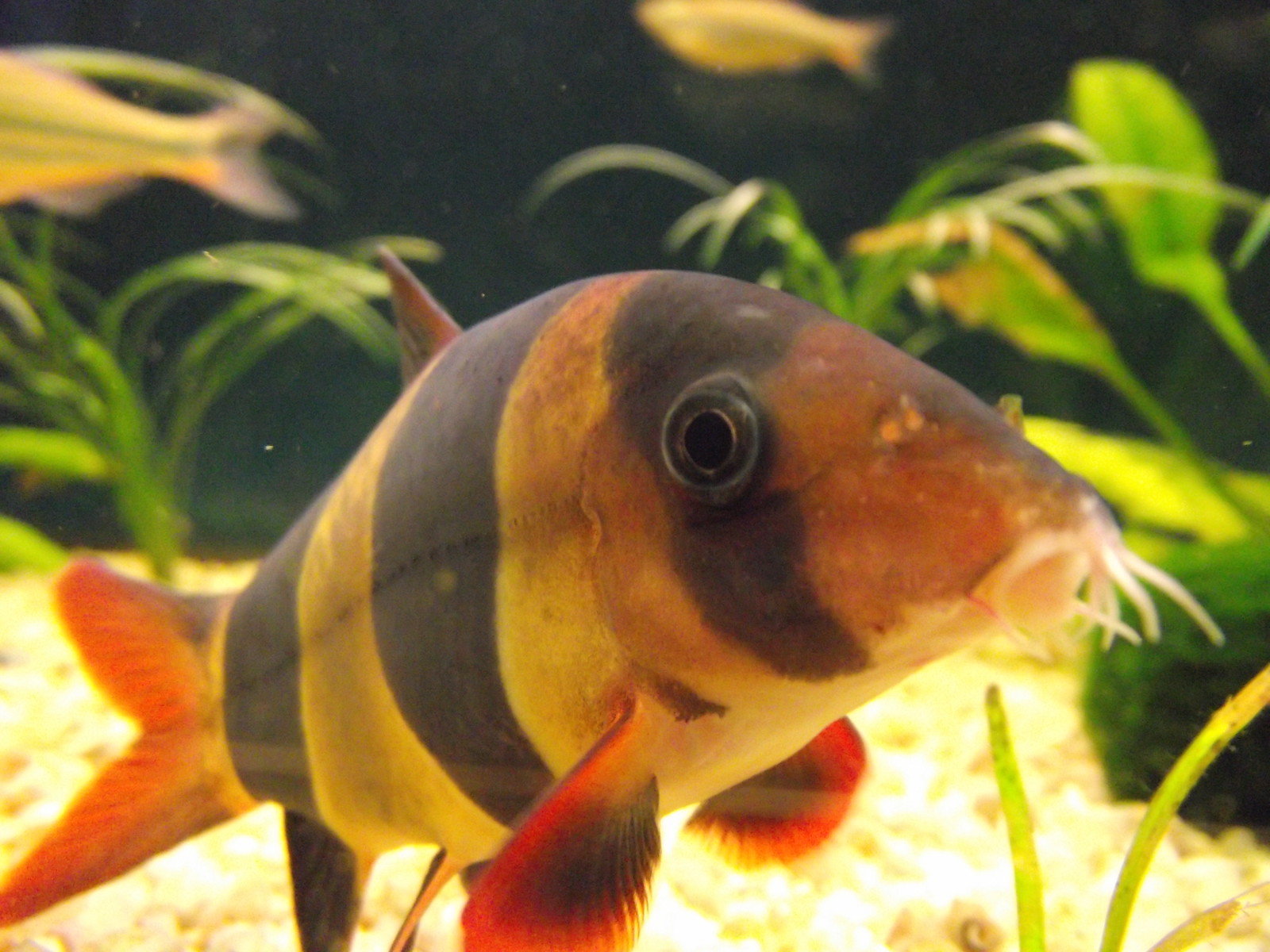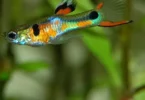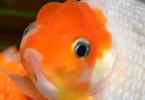Last Updated on February 10, 2023 by Matt
The clown loach is found in the fast flowing Indonesian rivers of Malaysia, Borneo, Sumatra, and Kalimantan. During spawning periods, they retreat upstream to flooded areas of the rainforest where they inhabit smaller streams with slow flowing water. Clown loaches generally prefer areas that are shaded and covered with plants, leaves and branches for them to hide in; which is why they work well in a planted aquarium in captivity.
Hence the name, clown loaches are known to be charismatic and funny fish with their quirky characteristics and behaviors that they will exhibit in your fish tank. Having a complex hierarchy, juvenile clown loaches will follow and imitate the adult female. This adult female is usually the alpha in the group. They are playful by nature and you will often see them lying on their backs or side and appear to be dead. However this is completely normal for clown loaches.
IN THIS ARTICLE
Clown Loach Summary
| Clown loach summary | |
| Family | Botiidae |
| Care level | Intermediate |
| Lifespan | 10+ years |
| Size | Up to 12 inches |
| Color | Orange with black stripes |
| Diet | Omnivore |
| Minimum tank size | 75+ gallons (as juveniles) |
| pH levels | 7.4 – 7.8 |
| Water hardness | 5 – 12 dGH |
| Temperature range | 77℉ – 86℉ (25℃ – 30℃) |
| Compatibility | Other clown loaches, community tanks |
| Tank set up | Tropical freshwater |
Clown Loach Appearance
As all loaches do, clown loaches have long pointed noses completed with bristle-like sensory organs, known as barbels, around the mouth; used to detect food. They also have a sharp spine underneath each eye that they can extend when in distress, they are also used in defense to warn off other fish or predators; they may even use them on humans in captivity if they feel threatened, so it’s important to be aware when handling your clown loach.
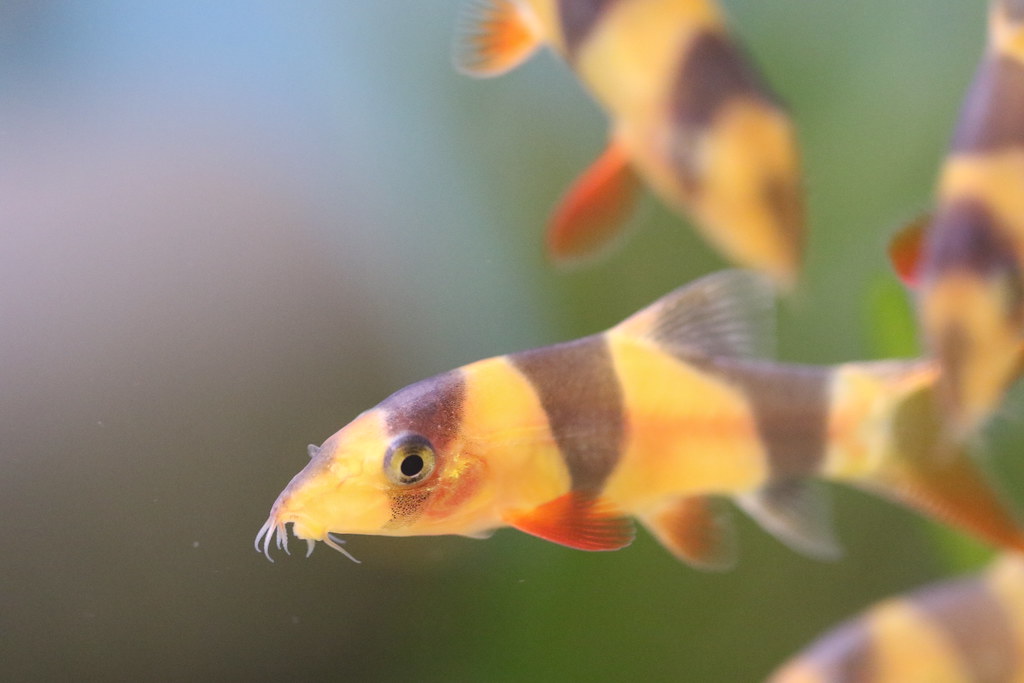
Credit: The Reptilarium (Flickr)
Clown loaches start off small, like all juvenile fish, however they can grow very large, sometimes up to 12 inches long. This proves to be a problem for new or inexperienced fish owners as clown loaches appear very sweet and small as youngsters, but they will eventually outgrow the tank. However, clown loaches do grow very slowly, so if this problem occurs there is always time to find a bigger aquarium for your clown loach.
Clown loaches have long and sleek bodies, making them excellent swimmers, and very fast too! They are often seen darting around the bottom of the tank in their groups making unusual movements. Their colorings are an orange/yellow shade, completed with three vertical black stripes along the body, two at the back and one running through the eye; they are also eye-catching due to their bright red fins and tail, making them a beautiful addition to a community tank.
Clown loaches are sexually dimoraic, meaning they carry different characteristics depending on the sex. To tell the difference between a male clown loach and a female clown loach, you need to pay close attention to the tail. Males have larger and more pointed tails that form a more distinctive V-shape, the tips on their tails also curve in slightly; whereas the females have straight tail tips, and their bodies are also slightly plumper than the male. However, this can be difficult to identify and they may be better off being identified by an experienced fish keeper or aquatic expert.
Housing:
The most important factor to consider when housing clown loaches, is that their main requirement is to be kept in a group, this group should be a minimum of 5 and can expand into the hundreds, depending on the space you have. When first purchasing your clown loaches, it is important to take this into account as their group size will determine their behavior within the tank. Having 1-3 clown loaches will result in them hiding throughout the day, and maybe seeing them once when they’re foraging for food; however they will be skittish and fearful when you approach the glass. Keeping 5 clown loaches will make them slightly more social, however they will still hide away for most of the time; even having around 12 clown loaches in one aquarium will mean they only appear half of the time.
If you are looking to see your clown loaches out of their hides and active for the whole day, you will need to be prepared to house a large number of 30+ clown loaches in a large aquarium. However, this is only suitable for experienced fish owners who will keep the aquarium clean and in the correct conditions for the loaches to thrive in, whilst also being aware of the size to which they’ll grow. For first time clown loach owners, we suggest starting with a minimum of 5-6 clown loaches, as this will give them a school to travel around the tank with but won’t be too many for a beginner to handle. Housing clown loaches with other compatible community fish will also encourage them to venture out of their hiding spots; but ensure that they are compatible, otherwise it can result in fighting.
As juveniles, when they are around 2-3 inches, a group of clown loaches are to be kept in a 75 gallon tank at a minimum; however, you need to be ready to move them into a larger tank when they eventually grow into adults. If you’re housing 5 adults, they will require at least a 150 gallon tank, every loach should have around 30 gallons; however with these fish, the bigger the tank the happier they will be.
Clown loaches thrive in a natural aquarium environment, with a mixture of substrates including sand and pebbles. This duplicates their natural environment and also prevents their bodies getting injured from harsh substrates like gravel. Clown loaches will also benefit from low lighting as they are more social and active in dark environments which is why they’re often seen active at night when the lights are off. Subdued lighting can be achieved by purchasing an LED aquarium light which can be dimmed. Many lights for planted tanks have this feature. However you can also use a normal aquarium light and add floating plants to the tank, this will shade the water and create a low light. Some great floating plants include Java Moss, Hornwort, water spangles, and Dwarf Water Lettuce.
Clown Loach Water Conditions and Temperature

Clown loaches generally come from Indonesia where the water has a high flow and is clean and clear, so replicating this in their captive aquarium will be the best way to allow them to thrive. This is easily done through installing a filter, clown loach aquariums usually require an external filter due to the large size of the tank, as internal filters are small and more effective in smaller aquariums. A reliable filter will ensure that the water is kept clean and free of any harmful bacteria or chemicals, whilst introducing beneficial bacteria into the water.
Clown loaches can be kept in temperatures of 77℉ – 86℉ (25℃ – 30℃), one of the most important factors to consider when keeping clown loaches is that they live longer and thrive in warm water, even though they can be kept in 77℉ the ideal temperature is 85 – 86℉. Warm water will also encourage the clown loaches to be more active and sociable in their enclosure, it is also a great preventative measure for the common disease known as Ich – as Ich usually occurs when the water temperature is too low for that species.
In order to keep these high temperatures at a consistent level, you will need to install a good heater in the aquarium, these are usually submerged in the water and attached to the glass at the back of the tank in order to heat the water equally in all areas of the tank, see our best aquarium heaters article. If the heater doesn’t include a thermometer, it is important to include a small separate one the place on the side of the tank to monitor the temperature, as clown loaches are pretty sensitive to the temperature of their surroundings – see our best aquarium thermometers article.
In terms of pH, clown loaches should be kept in the neutral zone of around 7, however they also work well between 6.8 and 8.2 – any higher or lower may introduce an illness. The water general hardness should be around 5-12 dGH, however this can go up slightly as clown loaches aren’t too affected by this. There doesn’t seem to be too much info around carbonate hardness ranges, but a range of 4-8 dKH should be fine.
In order to maintain the parameters in the water and ensure that there are no unwanted chemicals that may be raising or lowering the parameters, it is important to test the water every so often. This can be done by using aquarium test strips or a chemical test kit. We always recommend the same two testers, as they are the most reliable:
Aquarium test strips
These water test strips are a quick and easy alternative to the master test chemical kits, complete with four strips and a chemical chart. One of these strips is to be placed into the water for a short amount of time and the colors on the strip should then be compared to the color chart – this will then accurately tell you the levels of pH, nitrite, nitrate, carbonate and general water hardness.
Master test kit
- Contains one (1) API FRESHWATER MASTER TEST KIT 800-Test Freshwater Aquarium Water Master Test Kit, including 7 bottles of testing solutions, 1 color card and 4 tubes with cap
- Helps monitor water quality and prevent invisible water problems that can be harmful to fish and cause fish loss
- Accurately monitors 5 most vital water parameters levels in freshwater aquariums: pH, high range pH, ammonia, nitrite, nitrate
- Designed for use in freshwater aquariums only
- Use for weekly monitoring and when water or fish problems appear
This master kit is a more advanced alternative to the testing strips, with 7 bottles of testing solutions, 1 color card and 4 glass tubes. This kit will measure the pH, high range pH, ammonia, nitrite and nitrate, this kit may give you a more accurate result, however there is more of a risk of disrupting the process by putting too many or too little drops in the test tubes
Clown Loach Feeding and Diet
Clown loaches love their food and can become overly excited and competitive when food is put into their tank. They are bottom dwelling fish, meaning that they also feed at the bottom of the water column and are seen foraging through the substrate using their bristles to find small pieces of food; however they will not hesitate to swim at the top of the tank to reach floating foods. Seeing them dart up into the top of the tank is very cool! They are not picky eaters and will consume pretty much anything you offer them.
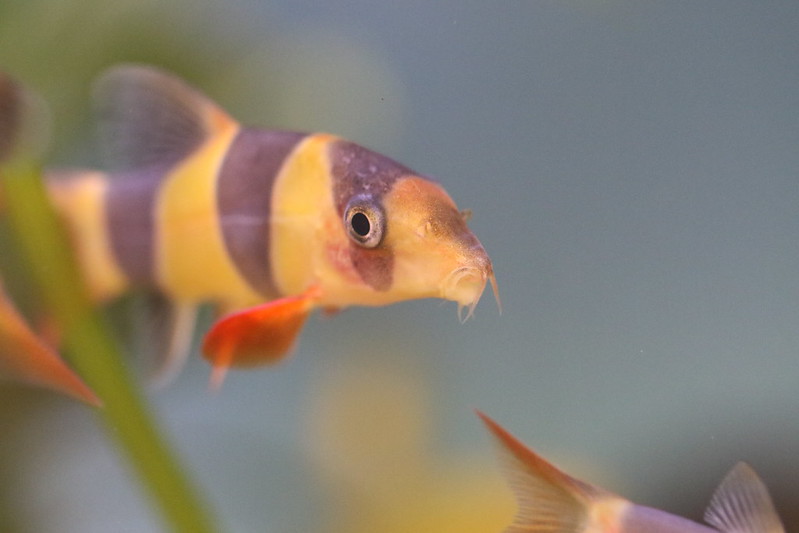
Credit: The Reptilarium (Flickr)
Their dietary requirements are very easy to meet in your home aquarium, as they will survive off a wide range of foods. Even though they are omnivores, clown loaches love live food and are often mistaken for carnivores. Therefore they will eat any snails around, which is great if you have a snail infestation. But not if you’re trying to keep them as cleaners! Commercial fish food including pellets, flakes and wafers give clown loaches all the nutrients they need, they will consume fast sinking pellets and also floating flakes – see our articles on the best fish food for bottom feeders and feeding your tropical fish.
These loaches also love to be fed invertebrates including blood and black worms and brine shrimp; this gives them a varied diet and allows them to experience all different kinds of foods. Even though shrimp and bloodworms are great for supporting healthy growth, they should only be fed a few times a week. Other worms should be fed only once a week as a treat. Snails can be fed as often as you like and are recommended to be given to your clown loach regularly.
Snails can be purchased online or in your local fish or pet store, or you can easily breed them in your own home in a small separate tank. Clown loaches should be fed around 2 times a day. Small amounts should be fed to prevent excess waste from polluting the water. This will also decrease the amount of cleaning you’ll have to do.
Being omnivores, they will also feed on any algae or plant matter that is in the substrate or on the aquarium plants. Clown loaches can also be given vegetables such as cucumber and zucchini; these should be washed well before placing into the tank to ensure that they don’t carry any pesticides on them.
Clown Loach Tank Mates
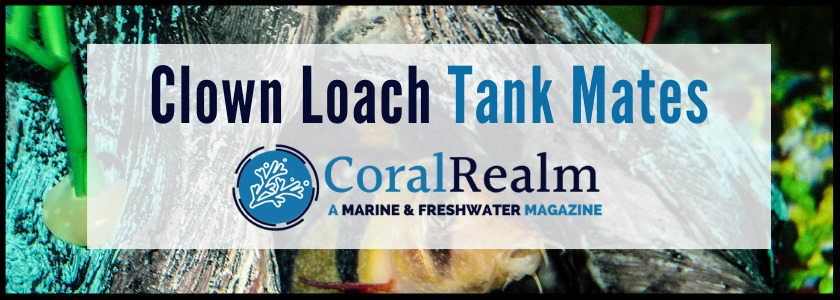
When choosing compatible tank mates for your clown loach, you need to ensure that they are housed with others in a group of at least 5; this will give them a better quality of life and ensure that they are comfortable in their enclosure. As clown loaches can grow very large, and have curious and boisterous characteristics, it is best to house them with calm and well mannered fish. Housing them with other species that are similar in personality can cause competition over food and space. It can also cause them to begin to fight and injure each other.
When choosing clown loach tank mates it is also important to consider their needs in terms of water conditions. As well as what temperature and conditions your aquarium will have. For example if you house your clown loaches at 85 degrees Fahrenheit, but want to add some White Cloud Mountain Minnows, you will be required to lower the temperature as these fish cannot survive in temperatures over 80 degrees. However lowering the temperature may affect your clown loaches; this is why it is important to ensure that all the species have similar requirements in order to be kept in the same enclosure.
Some compatible species for clown loaches include:
- All community fish – Guppies, Mollies, Barbs, Tetras
- Cichlids – Angelfish, Leopard Pigeon Discus
- Gouramis
- Bristlenose pleco
Other loaches such as Kuhli Loaches can be housed with clown loaches. However this should be done with caution and monitored regularly as they may harass and become aggressive towards each other due to them inhabiting the same area of the tank. They will both be bottom-dwellers after all! The tank size is also a big factor to consider when introducing tank mates as a large tank will allow the different species to have space to roam and escape each other. Whereas a smaller tank can cause them to irritate each other. In conclusion, you should avoid housing clown loaches with any predatory or aggressive fish.
Enrichment
As mentioned previously, clown loaches are curious fish that love exploring their enclosure. Providing enrichment such as hides, plants and foods will allow them to swim around obstacles, hide away and experience new textures.
Many fish are neglected when it comes to enrichment due to their species, however fish both enjoy and require stimulation and things to do in their tank just as much as land animals do in their captive enclosures. Enrichment comes in many forms and can create a lively aquarium that stands out in your home, as well as benefiting your clown loach.
There are several methods of enrichment, these include:
Environmental enrichment – Changing the appearance or function of the aquarium for the fish to experience a new environment. This also includes installing Aquarium LEDs into the tank.
Food enrichment – Using new foods to allow them to use different feeding methods
Social enrichment – Adding compatible species to the aquarium to give the fish company and new interactions
Environmental enrichment is one of the simplest ways to stimulate your clown loaches. This can include adding hides and plants into the tank to create a new and different environment. This prevents them from experiencing the same layout every day; however, this is not something you should do everyday. Constant changes can cause stress and confusion to all of your fish.
There are also some health and safety considerations when putting objects inside the aquarium:
- They should be big enough to prevent the fish from ingesting any decorations.
- The objects must also be strong and durable so that they don’t break and get ingested by accident
- They should not contain any harmful chemicals that may contaminate the water
- Lastly each and every item must be thoroughly washed before introducing them into the aquarium to remove any particles that may be on the items.
Clown loaches live well in a tank with real plants both floating and planted, these can include Java Fern, Java Moss, Water Spangles, Hornwort, and pretty much any live plant that is sold in your local aquatic store. However, clown loaches are often seen nipping at plants and roughly foraging through the substrate around their roots. Therefore monitor any newly inserted plants closely as their short roots can be disrupted by the loaches behavior.
Even though clown loaches are social, they also love hiding away behind driftwood and plants, and especially love small spaces; so placing hides around the aquarium is a great way to suit this need.
Here are some hides that we recommend for your clown loaches:
Hides:
Breeding
With clown loaches, the majority sold for aquariums are wild caught as breeding them in captivity is virtually impossible. Some females can be successful at spawning in an aquarium. However there’s a very high chance that they won’t be fertilized. Clown loaches are also known to eat eggs before they hatch; this will most likely happen if the spawn is successful when attempting to breed them in captivity.
However if you are interested in breeding your clown loaches, here are some steps we recommend you to take:
- Place the chosen male and female in a separate tank, you do not want any other fish in their surroundings when attempting to breed them
- This tank should be at least 77-79 degrees Fahrenheit
- This tank should have a pH of 6.2 – 6.4, this is the ideal range for breeding
- If the release and fertilization of the eggs are successful, ensure the male and female are removed immediately, otherwise they may eat the eggs
- Fertile eggs will be pink and will move around, whilst infertile eggs will turn brown
- If the eggs are hatched successfully, the fry can be fed live organisms and moved onto small shrimp, worms and flake food as they grow.
Common health issues
The most common disease seen in clown loaches is Ich, also known as White Spot Disease. This is a protozoan disease caused by a single-celled parasite and results in noticeable white spots all over the body. Other symptoms can include weight loss, scratching on sharp objects, and lethargy.
This is commonly seen when the water temperature is too low, particularly when clown loaches are housed with other species that require a lower water temperature. Many inexperienced loach owners don’t realize that clown loaches thrive in warm water. Placing them in those cool temperatures can make them stressed, and will certainly make them more susceptible to Ick, as the parasite survives in cooler temperatures.
Ick can occur when the fish is stressed. So removing any stress-inducing factors such as aggressive tank mates or being moved to a large enclosure will also help prevent the occurrence of Ick.
To aid in preventing health issues ensure a strong filtration system, such as a canister filter, with mechanical, biological, and chemical filtration. Regular water changes to ensure correct water parameters are also essential. Water changes can be made easier using a product like the Python water changer.
Are clown loaches the right fish for you?
Clown loaches are social fish that will make a great addition to a large community tank, as long as the temperatures are warm enough for them to thrive in.
They are best kept in the care of experienced fish keepers due to their demanding temperature requirements and their susceptibility to diseases.
If you can give these fish what they require to thrive in your aquarium, it’ll be great to watch them exhibiting their weird and wonderful behaviors; whilst creating an eye-catching display in your home.
Featured image credit: Beckie (Flickr)

